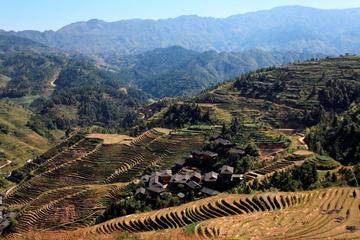Longji Rice Terraces
TIME : 2016/2/22 10:11:14

Longji Rice Terraces
For the farmers who reside in the Longji region of Southern China the soaring rice terraces are simply a way of life. For the thousands of annual visitors who make the two-hour journey from the city of Guilin, however, the Longji rice terraces are an iconic symbol of Chinese agriculture and one of the most photographed sites in the country.
Here in Longji, layer upon layer of cultivated terraces stretch skywards on steep slopes, at some points they slope at over 50° angles. Despite the dramatic grades of the mountainside, however, traditional Chinese rice farmers have managed to sculpt the hillside into orderly terraces which annually yield massive harvests of rice. Though there really isn’t a bad season to visit the Longji rice terraces, the early summer months of May and June are popular for photographers as this is the time of year when the terraces are irrigated and cast a mirrored effect which crawls up the walls of the valleys.
Also known as “The Dragon’s Backbone,” the multi-tiered terraces closely mimic the scales of a dragon’s back while the ridge of the summit weaves in such a way it isn’t hard to imagine a dragon lying down. More than just a scenic set of terraces, however, visitors are able to walk among rural and traditional villages which still house ethnic minority groups such as the Zhuang and Yao people. The terraces are actually a product of the Zhuang people who were forced to live in the hills over 500 years ago. Needing to adapt to their new surroundings they devised the dramatic system of terracing, which dominates the mountains today. Nearby, in the Yao villages, women still grow their hair for the entirety of their adult lives and let it cascade in falling ribbons of black nearly all the way down to their feet; the resulting appearance is a unique cultural favorite among the throngs of Longji visitors.
